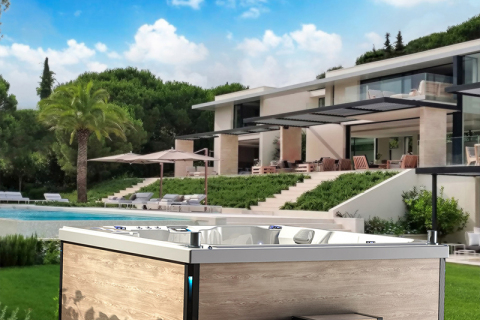
- Home
- >
News
Unlike built-in bathtubs, freestanding whirlpool bathtubs are not fixed to the wall, but rely entirely on the support frame at the bottom of the bathtub to maintain stability. The support frame is usually made of metal or high-strength plastic and has sufficient load-bearing capacity to ensure that the whirlpool bathtub will not tilt or tip over.
Once the power goes out, the first thing to do is to ensure that all electrical equipment in the outdoor whirlpool bathtub is turned off to avoid current surges or system damage after the power is restored.
If you choose to place a whirlpool bathtub on concrete paving tiles, the first consideration is to ensure a stable foundation. In order to improve the bearing capacity and stability of the ground, it is usually necessary to add a solid foundation to the bricks.
Power supply problem is one of the common reasons why outdoor whirlpool tubs cannot start. If the power supply to the whirlpool tub is out of power, the entire device will not work properly. Users first need to check the power outlet, switch and circuit fuse to ensure that the power supply is normal.
The bathtub's filtration system will work for 30 minutes to 1 hour during the impact process to ensure that the water quality meets the hygienic standards. However, the length of the filtration time also depends on the chemical agents used, the type of disinfection system (such as ozone disinfection, ultraviolet disinfection, etc.) and the degree of water pollution.
If you use the whirlpool bathtub frequently every day or every week, the water and air flow in the jets will be more frequent, and the residual dirt will accumulate faster. For frequent users, it is recommended to clean the jets once a month to ensure smooth water flow and avoid clogging.
The air pump will make a certain noise when it is operating normally. Although this sound is not piercing, it should be even and continuous. If you find that the air pump is not very audible, or only intermittently, there may be something wrong with the air system.
Impurities in water are one of the common reasons for inaccurate chlorine test results. The water in the whirlpool bathtub contains not only chlorine, but also a variety of other substances, including organic matter, minerals, dissolved gases, and pollutants from the human body.
Whirlpool bathtubs are not much different from ordinary bathtubs in appearance, but their interior is much more complicated. It is equipped with multiple jets, water pumps and air mixing systems, which are usually installed on the inner wall or bottom of the bathtub.
● Turn off the water supply to the bathtub and make sure the nozzles stop working. ● Drain the bathtub. ● Add about 2-3 cups of white vinegar to the bathtub, start the water pump, and let the vinegar water flow through the nozzle and pipes. ● Start the bathtub pump and let the vinegar water circulate for about 15-30 minutes to ensure that the vinegar water fully contacts the nozzle and the inside of the pipe.
Its working principle involves multiple mechanical and electrical components, which are exposed to the outdoor environment for a long time and are inevitably affected by factors such as weather, temperature changes, and pollutants. Therefore, it does require certain maintenance work to keep it working properly.












